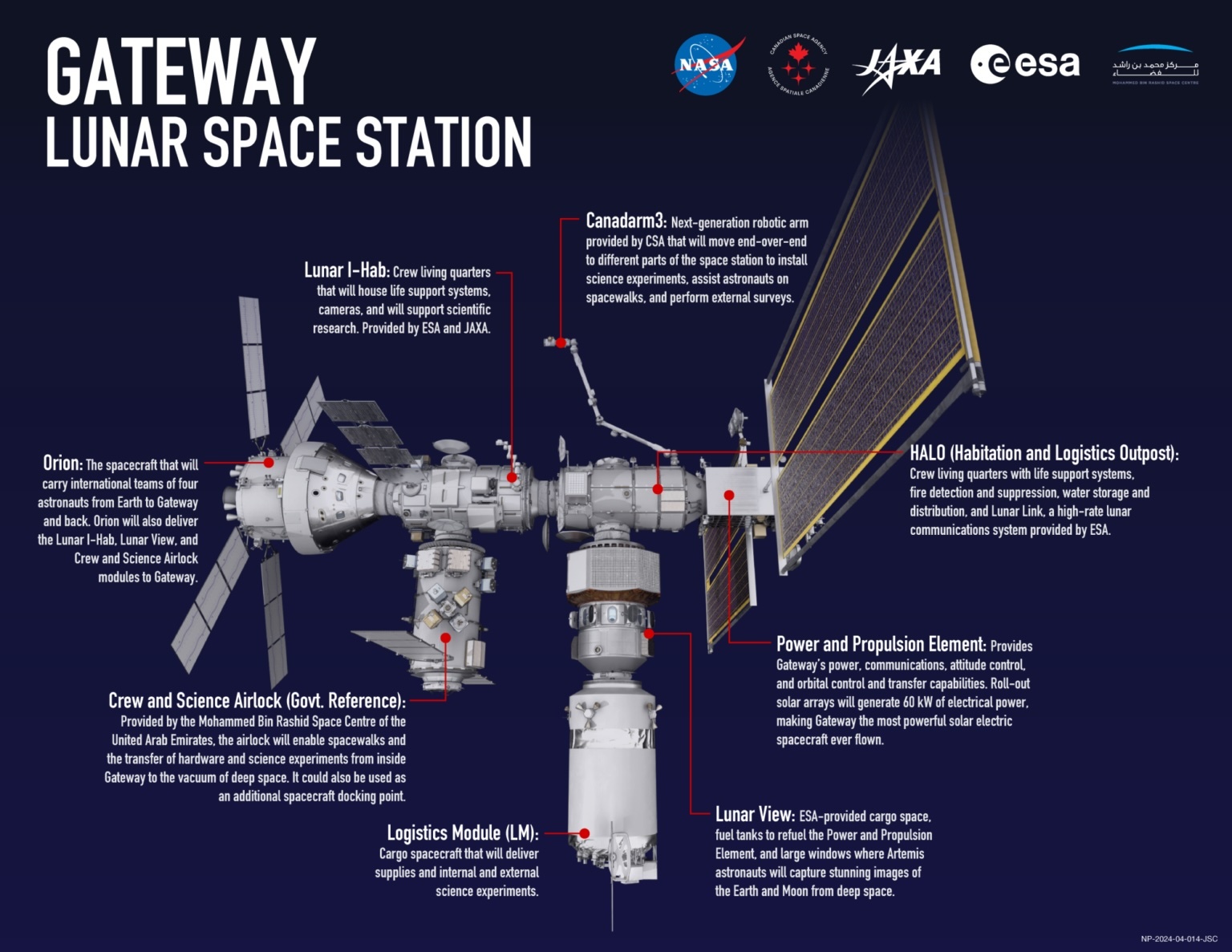7.06.2025

Illustration of the Gateway lunar space station showing the international partner contributions. Credit: NASA.
The Senate committee that oversees NASA released its proposal for the reconciliation bill today signaling support for NASA’s current Moon to Mars plan, not the Trump Administration’s version. The $10 billion designated for NASA includes full funding for the Gateway lunar space station, two more SLS rockets and a fourth Orion spacecraft. None of that is in the Trump plan.
The “One Big Beautiful” reconciliation bill that passed the House last month is now before the Senate, which is developing its own version. In both chambers, specific committees were assigned to come up with proposals to increase or decrease spending to meet previously set targets. The House Science, Space, and Technology Committee wasn’t one of the House committees involved in the process, but the Senate Commerce committee is.
Commerce Committee chairman Sen. Ted Cruz (R-TX) released his text today. Overall he said it will reduce deficits by $40 billion over a decade and rescind $1.4 billion in “wasteful spending,” but NASA gets an increase of $10 billion primarily for the Moon-to-Mars (M2M) human spaceflight effort restoring cuts proposed by the Trump Administration.
The money is a FY2025 supplemental, but would not have to be completely spent until 2034. According to the committee’s section-by-section summary, 50 percent would have to be obligated (under contract) by September 30, 2028, and 100 percent by September 30, 2029, but not spent (outlayed) until September 30, 2034.
The Trump Administration’s FY2026 budget request would cancel Gateway and end SLS and Orion after Artemis III. It also reduces crew and cargo flights to the International Space Station (ISS) and limits scientific experiments to those that support the M2M effort only.
By contrast, the committee provides:
- $2.6 billion to fully fund the international Gateway lunar space station being built in cooperation with Europe, Japan, Canada, and the United Arab Emirates, calling it “critical” for a sustained human presence at the Moon.
- $4.1 billion for SLS rockets for Artemis IV and Artemis V. The Trump Administration wants to replace SLS with less expensive commercial rockets and the committee notes this funding “does not preclude integrating new, commercial options if and when they become available.”
- $20 million for a fourth Orion crew spacecraft for use with Artemis IV and reuse on subsequent missions.
- $1.25 billion for the ISS to ensure there is no gap between when the ISS ends in 2030 and new commercial space stations are in orbit to replace it.
The committee also allocates $325 million for the U.S. Deorbit Vehicle to propel the ISS from orbit into the Pacific Ocean at the end of its lifetime. NASA awarded $843 million to SpaceX last year to build the USDV, but that did not include launch. The committee’s bill says the $325 million is to fulfill the contract, but it’s not clear if that’s to cover the launch or additional costs of the USDV itself.
The committee also calls for spending $700 million for a Mars Telecommunications Orbiter that would be procured through a competitively bid fixed-price contract with a U.S. commercial provider to be delivered by December 31, 2028. The MTO would support both a Mars Sample Return mission as described in the 2017 NASA Transition Authorization Act and future robotic and human Mars missions.
Finally, the bill funds $1 billion in “improvements” at five NASA fields centers: Stennis in Mississippi ($120 million), Kennedy in Florida ($250 million), Johnson in Texas ($300 million), Marshall in Alabama ($100 million), and Michoud in Louisiana ($30 million).
The reconciliation bill’s fate is far from certain, having passed the House by the closest of margins 215-214-1 after extensive involvement by President Trump to win enough Republican votes. All Democrats voted no.
The Senate is expected to make changes meaning the bill will have to go back to the House and get passed again, but Elon Musk’s sudden intense opposition and rift with Trump will complicate the situation in both chambers.
The reconciliation bill is separate from appropriations. Trump just sent the details of his FY2026 budget request to Congress on May 30. Trump proposed cutting $6 billion, or 24.3 percent, from NASA’s budget including a nearly 50 percent cut to science. The Commerce Committee’s portion of the reconciliation bill barely addresses science, but appropriators will have their own chance to weigh in on NASA’s future as the appropriations process gets underway.
Quelle: Space and Technology Policy Group
